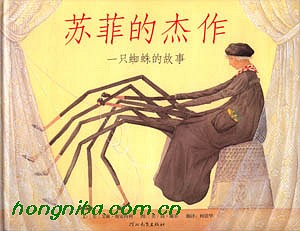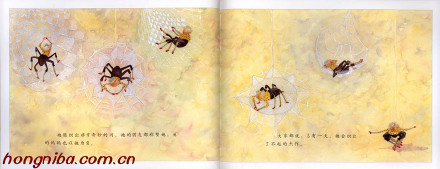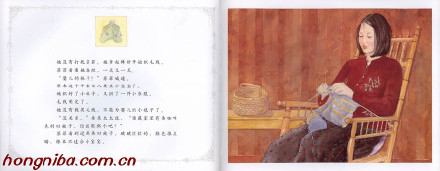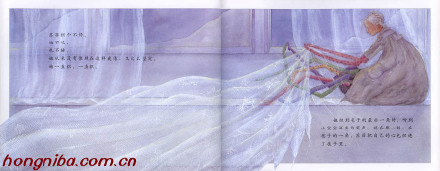
The day before yesterday, I saw a mother talking about “Sophie’s Masterpiece” on the Red Mud Forum. I was very inspired and joined in the conversation.
When I first encountered the Traditional Chinese version of this book, I didn’t have a strong impression. I just thought it was a wonderful picture book, somewhat similar to the story of Charlotte’s Web, and very suitable for children. That was all. After the Simplified Chinese version was published, I often read it to my children, especially recently. Through interacting with them, I gradually discovered what a beautiful book it is.
I haven’t specifically studied the background of this book, so I’m just sharing some of my personal thoughts from reading it.
I have told this book to children of different ages, from as young as 4 or 5 years old to upper grades of elementary school and junior high school students, and their reactions were different.
There was a group of first-grade children (from a school for children of migrant workers) to whom I was unable to read the entire book, so I had to switch to a reading-aloud format midway, skipping some of the detailed language descriptions. But in a small mountain village in Hanwang, another group of children of about the same age were able to listen to me quietly to the end.
I particularly emphasize “read it in its entirety” because I think the text of this book is very beautiful and worth listening to and reading quietly and savoring carefully.
In the process of talking to the children, I found that many of them do hate spiders, especially the girls. So this story surprised the children a little, because it was obvious that they all liked Sophie.

The younger grades were less likely to engage in a discussion about why Sophie knitted a blanket for the baby, but I once successfully got a group of sixth graders to express their feelings. One child, among them, said that it was because the young woman smiled at Sophie.
Sophie’s image and story remind me of those artists who, despite their lifelong decline, understand the art of living (or the art of living for life), but no one understands them, or they don’t have the opportunity to showcase this talent (even to just one or two people). Young women are Sophie’s audience. It’s a bit like O. Henry’s “The Last Leaf.”
The comparison between “Sophie’s Masterpiece” and “Charlotte’s Web” is also quite interesting. It’s a long story. Both stories have babies at the end, but in “Charlotte’s Web,” Charlotte’s three daughters are left behind. This is unique in children’s literature and is full of meaning.

Why didn’t the artist make Sophie cuter? I think she’s already cute enough. That’s how Sophie looks. Thinking she’s ugly is just a human perspective. From a spider’s perspective, the landlady, the captain, and the cook don’t look particularly pretty. :) The Oriental woman isn’t particularly beautiful, but when she smiles, she looks quite pretty. I also think Sophie looks pretty when she’s leaning on that hairpin and looking at the moon. Beauty isn’t about outward appearance, but about the perception within a specific context and perspective.
To like Sophie, you have to like her for who she is.
So the beauty of Sophie’s masterpiece lies only in this story, in that gray apartment, on the gray floor above, by the gray window, beside the bed of a poor mother, with the newborn baby covered in a blanket that looked like a small blanket prepared for a prince. Only those who are truly attentive can perceive everything woven into the blanket, because it is invisible to ordinary eyes.

【About the works and creators】(Reprinted fromRed Mud Website)
“Sophie’s Masterpiece” tells the story of a tiny spider, weaving a sturdy life with fine silk threads. The world of spiders is truly fascinating, but most people don’t understand them well. When they encounter them, they react with disgust or fear, much like the landlady, the captain, and the cook in this story. Sophie perseveres, creating pieces with diverse functions. Her skills are refined through repeated setbacks, and she ultimately completes the “great masterpiece” predicted by her childhood friend. At that moment, “Sophie weaves her own heart into it.” Sophie not only completes a blanket of warmth for a new life, but also uses her final remaining strength to create a masterpiece “like one meant for a prince.” This truly inspires awe and wonder!
About the Author:
Eileen Sianelli
Spinelli, a bestselling storyteller, specializes in heartwarming, everyday themes. When she was young, living in a rented apartment, she met a young, impoverished mother who, unable to afford a blanket, had resorted to using a worn, brown blanket provided by the landlady for her newborn baby. Years later, Spinelli still vividly remembered the incident. She wrote the story of Sophie, fulfilling her original wish to give the baby a beautiful blanket. She and her husband, also a writer, settled in Pennsylvania, USA.
Jane Dell
Dyer, an award-winning illustrator who has illustrated more than twenty picture books. She sought information for Sophie’s story from a small herb called Pisaurina.
Mira’s spiders inspired her work. Most spiders build webs to feed, but this particular species, known for its brooding skills, uses its webs almost exclusively as a means of protecting its young. Dale successfully portrays the character of Sophie, weaving a delicate and moving storyline. She currently lives in Massachusetts, USA.